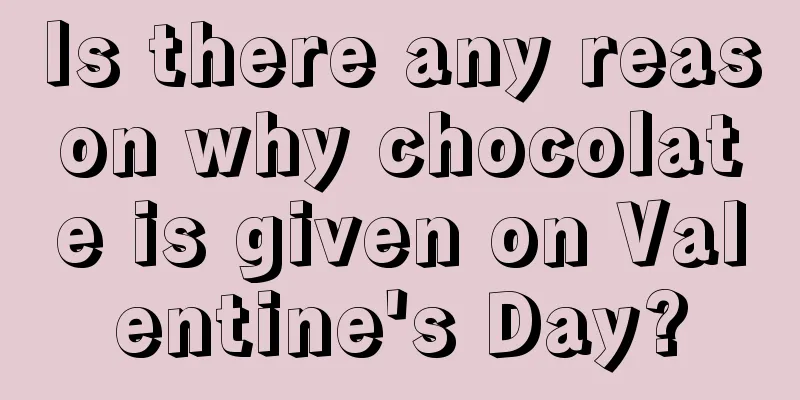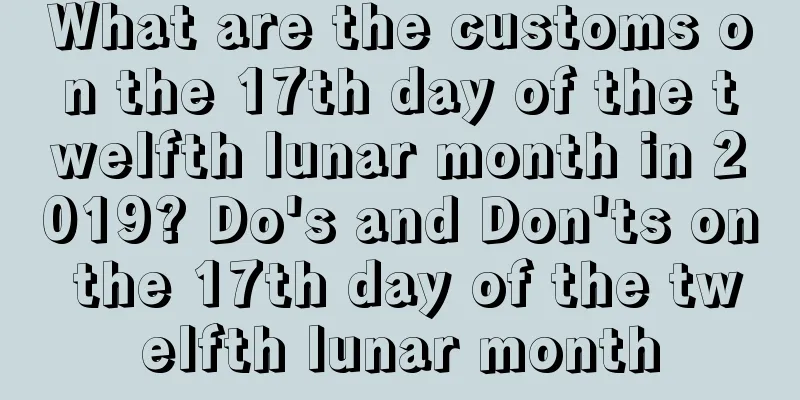Is there any reason why chocolate is given on Valentine's Day?

Introduction: Giving chocolates and roses on Valentine's Day seems to have become a classic combination for Valentine's Day, but why do we give chocolates on Valentine's Day and how did it evolve? Now let’s follow the editor to learn about the historical origins of giving chocolates on Valentine’s Day. During the first month of the lunar calendar, you will have a good year. The first month is the most important month of spring. Mr. Shui Mo will share with you some knowledge about January.Reasons to give chocolates on Valentine's DayThe most reliable reasonAccording to records, Japan only started celebrating Valentine's Day by giving chocolates in the 1950s. The Japanese economy was in a very difficult situation at the time, and many people were still struggling to find food and clothing. It was in this context that an American chocolate company launched the Valentine's Day chocolate delivery business in Tokyo for the first time. Unfortunately, only five pieces of chocolate were sold that year. The merchants did not lose heart, and they promoted this holiday and sold chocolates every year around Valentine's Day until the practice of giving chocolates on Valentine's Day became "deeply rooted in people's hearts." In Japan today, Valentine's Day is called "Chocolate Day". According to statistics, the annual sales of the Japanese chocolate market is as high as more than 400 billion yen, and chocolate sales during Valentine's Day account for two-thirds of the total sales.Today, in economically developed Japan, the people to whom chocolates are given on Valentine's Day are no longer limited to lovers. Its scope has expanded from private affairs between men and women to family affection, and to interpersonal relationships in companies, institutions, and schools. However, the principles of giving chocolates on Valentine's Day, February 14, have not changed: only women can give to men, and men are not allowed to give to women. Therefore, there are now two Valentine's Days in the Japanese calendar each year. March 14th is also Valentine's Day. On this day, men give white chocolates to women in return, which is also called "White Day." Tracing the Origins of Valentine's DayLegend has it that Valentine's Day originated from the ancient Roman Lupercalia, when it was said that birds began to mate. The custom at that time was: during the Lupercalia, each young man drew lots from a box. The box contained strips of paper with young women's names on them. Whoever the lot was drawn from would become the young man's sweetheart. Later, this festival was changed to commemorate a Christian saint named Valentine.Saint Valentine, a young Christian missionary in ancient Rome, risked his life to spread Christianity and was arrested and imprisoned. He moved the old jailer and his blind daughter and received their careful care. Before his execution, Saint Valentine wrote a letter to the girl, expressing his deep love for her. On the day he was executed, the blind girl planted a red-flowering apricot tree in front of his grave to express her love for him. That day is February 14th. Nowadays, on Valentine's Day, many young men make St. Valentine's postcards into exquisite handicrafts, cutting them into butterflies and flowers to express their deep affection for their lovers. The way men and women express their love is that boys usually give their sweethearts a red rose, while girls give their sweethearts a box of heart-shaped chocolates. The most scientific versionFirst of all, psychologically speaking, the taste of chocolate is like the taste of love, a mixture of sweetness and bitterness. As soon as you put it in your mouth, you can enjoy the pleasure of melting, just like the whispers of a lover, warm and cozy.Secondly, eating chocolate can replenish physical energy and strength and make people feel happy. This also carries the gift giver's good wishes for his lover, wishing that love will be as sweet as this chocolate, and also wishing the lover to be healthy and happy. Third, chocolate can increase the level of a chemical in the brain called "serotonin". It can bring a sense of peace to people, better eliminate tension and relieve stress. Very suitable for today's young people. Fourth, scientific research has shown that phenylamine, one of the main ingredients of chocolate, can cause certain subtle changes in human hormones, which can make your heart beat faster, just like experiencing a passionate love affair. Summary: Through the above article, we know the historical reasons for giving chocolates on Valentine's Day. I hope you will like the above content. I wish that friends who are in love will have a relationship as rich and long-lasting as chocolate in the new year, and that single friends will find the right person! After reading this article, there are more exciting contents in the special topic of the first month of the lunar calendar. Let’s take a look! |
<<: Valentine's Day dating strategy: How to spend Valentine's Day in the most romantic way
>>: 10 Feng Shui tips to bring luck and romance on Valentine's Day 2017
Recommend
What is the lunar calendar for Xiaohan in 2022, and where is the God of Wealth of Xiaohan?
The north wind is howling, and the Lesser Cold sol...
Is the 11th day of the sixth lunar month in 2018 suitable for worshiping ancestors? How is today's time?
Ancestor worship and praying for blessings have pr...
Is it okay to have a caesarean section on the fifth day of March during the Qingming Festival in 2022? How is the fortune of a child born on this day?
The third month of the lunar calendar is the last ...
Cold Food Festival 2020 - Is March 11 a good day for engagement? Which season is the Cold Food Festival?
Introduction: Generally, you need to choose an aus...
Is it suitable to install a bed on the 25th day of the twelfth lunar month in 2020? Analysis of the Feng Shui of installing a bed
Introduction: When setting up a bed, you need to p...
Is the weather still hot after the autumnal equinox? Does the autumnal equinox mean the beginning of autumn? What are the characteristics of the autumnal equinox?
In ancient times, the Autumnal Equinox was the Moo...
How about opening on the 11th day of the first lunar month in 2021? What are the auspicious days for opening a business in the first month of the lunar year?
Every day has its good and bad days. If you want t...
Is the Laba Festival of the lunar calendar in 2019 suitable for sacrifices? What does it mean that after Laba it is the New Year?
Introduction: It is also necessary to choose an au...
Can the daughter-in-law go to visit the graves during the Qingming Festival? Should my son buy white or colorful floats when visiting the grave during the Qingming Festival?
Speaking of visiting graves during the Qingming Fe...
When is the best time to get married in the twelfth lunar month of 2019? Is it good to get married in the twelfth lunar month?
There are many folk sayings about the twelfth luna...
Is it appropriate to pray on the day of Lesser Heat on July 7, 2019? What does Lesser Heat mean?
Introduction: Generally, you need to choose an aus...
What is the fate of a girl born on the autumnal equinox, August 17, 2021?
The heat retreats and the sky becomes clear, the a...
What is the fate of a boy born on May 14th of the lunar calendar in 2018?
A person's life is actually determined at the ...
Can I get engaged on May Day 2017? How is life?
Introduction: Engagement is an important ceremony ...
What is the zodiac sign for April 19th, 2021? Which zodiac sign is suitable for interaction?
Sophora japonica flowers bloom in April, so it is ...









